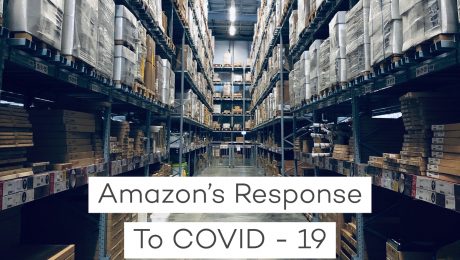Amazon Suspends FBA Shipments For Non-Essential Items In Response To Coronavirus COVID-19
According to Fulfillment by Amazon, the Coronavirus, also known as COVID-19, has been greatly impacting Amazon customers, sellers, and employees.
Since people are staying in their homes trying to prevent the COVID-19 from spreading any further, online shopping has increased dramatically leaving household items low in quantity or completely out of stock. Due to this dilemma, Amazon has chosen to temporarily prioritize household items such as staples, medical supplies, and other high demand products that have been entering their fulfillment centers in order to quickly obtain, restock, and deliver products to customers as fast as possible.
Amazon says that for any other products than these, they have temporarily disabled FBA shipments and they are taking a similar approach with retail vendors as well. This will be in effect until April 5th 2020. Amazon will communicate when they resume their regular operations. Any shipments created before March 17th 2020 will be received at Fulfillment centers. You can learn more about this on this Help page. It’s also important to note that Selling Partner Support does not presently have any further guidance.
Amazon understands how this change might impact our businesses and says how they most certainly did not take this decision lightly. They are working as hard as they can to increase capacity and are trying to quickly hire 100,000 new full and part-time positions at fulfillment centers across the US. They thank their Amazon customers, sellers, and employees for their understanding and patience as they prioritize the above products in response to COVID-19.
What Actions Could You Take?
- Consider increasing quantities on any pending orders by up to 5% without penalty
- Ensure that you have a back-up means of fulfilling inventory, such as your own warehouse or 3PL to do fulfillment. We advise all clients to create a duplicate SKU for each ASIN, one is used for FBA and one is merchant fulfilled or SFP. This is allowed by Amazon and is a good tactic to ensure sales momentum is not impacted greatly when you run out of stock in FBA. You should also be exploring alternative fulfillment to diversify into other channels such as Walmart, eBay and other marketplaces as a means of diversifying your sales revenue through multiple channels
- Consider adjusting your prices to maintain a run rate that does not run out of stock, but be careful not to increase prices too drastic or Amazon may suspend your buy box eligibility due to price gouging concerns
- If you have a regular cadence of planned inventory allocations to Amazon, you will want to account for this impact by increasing future shipments as needed
- Many sellers are seeing decreased sales of non-essential product sales recently, so you may find that additional inventory is not needed and this may be good to keep inventory balances in check
If you have questions about selling on Amazon, optimizing your listings and advertising campaigns to peak performance, please contact Prime Guidance for a free account consultation at info@primeguidance.com.
Author | Claudia Yates, Marketing Specialist
- Published in Other
Strategically Thinking Beyond Amazon in 2020
The Current Landscape
The competitive landscape on Amazon is greater than it ever has been. If you are an authorized re-seller or an online retailer of various brands and products, you are dealing with an ever-increasing amount of legacy and traditional brands going direct to consumer.
These omnichannel moves by legacy brands was once prevalent only on their own D2C website, but over the last 5 years has rapidly increased on marketplaces such as Amazon and eBay.
Amazon private label sellers, some who pretend to be untouchable, are now faced with a formidable foe with the largest wave of Asian direct manufacturers, launching private label products on Amazon.com. Marketplace Pulse reported, in January of this year, that 49% of the top Amazon sellers are Chinese, while the U.S. has dropped to 47%.
Along with increased competition, these Asian sellers often employ “black hat” tactics to gain advantage in product rank and reviews, leaving U.S. merchants with few choices left except to increase ad spend and merchandising techniques.
Security Through Diversity
As much as I love Elon Musk dancing or his podcast interview with Joe Rogan, I would never put my entire IRA 100% allocated in Tesla. As much as no other marketplace or shopping engine can seem to match the might of Amazon, sellers and merchants must secure their future through diversity, just as you would with your investment portfolio.
Engage and expand on marketplaces such as:
- eBay
- Wal-Mart
- Target+
- Wayfair
- Google Shopping Actions
- Rakuten
- Wish
- Overstock
- Back Market
- Sears
- Jet
- TopHatter
Check out Channel Advisor’s List of Channels as inspiration:
Being involved in the ownership, management, and operations of over a dozen multi-channel e-commerce retailers over the last decade, I have found that almost 100% of the time secondary marketplaces were more profitable than the #1 sales channel. Analytical data points on financial statements such as return %, marketplace fees, and advertising as a % of sales were almost always higher on Amazon.com, sometimes even double, that of secondary channels.
Building a business through these secondary channels can be done, but it requires a different strategy than Amazon and employing the usual strategies or pretending like it’s a mini-Amazon is never successful.
What To Really Do
Before the world of selling goods revolved around 5-star ratings and info graphics, business was done by merchandising and relationships.
While analytical strategies such as page rank, reviews, images, video are still extremely vital on any channel outside of Amazon, these secondary marketplaces require daily attention by someone in your company that cannot be replicated by some automated software or cheap virtual assistant.
In my experience, relationships, in person meetings, dinners, etc. are also extremely vital to representatives from companies mentioned above. A lot of the decision makers and representatives from these companies are open to having monthly or weekly calls with you and your team members to create a roadmap to success.
Unique marketing opportunities often present themselves as well, such as, but not limited to:
- Daily deals
- Front page or category page placement for your business and/or select merchandise
- In app marketing
- E-mail marketing
- Ability to advertise products through affiliate channels
After that, it requires a well-trained team that understands each marketplace in depth, deploying and testing multiple strategies and then continuing to work on improving sales performance across each site.
If you have questions about selling on Amazon, optimizing your listings and advertising campaigns to peak performance, please contact Prime Guidance for a free account consultation at info@primeguidance.com.
Author | Matt Kubancik, Direct of Partnerships and Senior Consultant
- Published in Other


